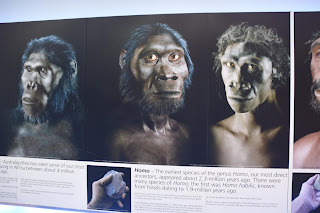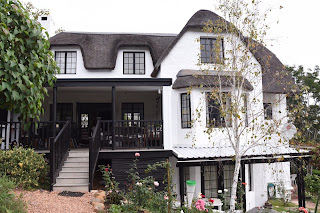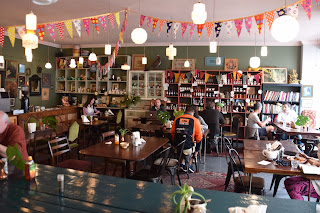After being picked up in Pretoria by our Afrikaans guide Mr. Gert we drove about 45 minutes to the UNESCO site: Cradle of Humankind. The museum is housed above several limestone caves where bones of our earliest ancestors have been found. In the field in front of the museum are about 100 life-size bronze sculptures by various artists of men and women considered instrumental to the “Long Walk to Freedom”, title of Mandela’s autobiography. The sculptures at the back of the group start with several tribal leaders/warriors that resisted European colonization and occupation like Shaka Zulu, dressed in his traditional skins. Later sculptures include Dr. Martin Luther King, Fidel Castro, the white leader of the communist party (I don’t remember his name) and Bilko. Finally, leading the procession of these lifelike characterizations was Mandela in a suit, his fist raised, and his endearing smile. They said they will add up to 400 more sculptures in the future.
 |
| Shaka Zulu |
 |
| Robin with Freedom Fighter |
 |
| Field of Freedom Fighters |
 |
| Madeba and Winnie. |
Like many limestone caves, these labyrinths extend for hundreds of miles under the semi-desert dotted with shrubs and Acacia trees. The entrances that were discovered before enlarging for tourist access were just holes in the ground surrounded by shrubs creating great hazards historically and today. There are stalagmites and stalactites, underground rivers and lakes, explored by spelunkers in the twentieth century. In one cave piles of hominid bones were found. Based on the lack of access and random dispersal of the bones, archeologists determined that the hole above ground was used for burials. The ancient hominids deposited bodies into the dark pit that was impossible for them to enter. The other site we explored had a fascinating story how a complete 3.5 million y.o. skeleton was discovered.
In the 1960s during the initial exploration of the cave a bone was found and ended up in a drawer in a university collection. There was no interpretation of the bone, only the cave location where it was found. Years later a professor of archeology scanning through the drawers immediately identified that is was not an animal bone, but a bone from a small humanoid foot. With the cave location identified and help of the locals, they found the access hole and within four hours found the stub end of another bone protruding from the compressed matrix of rock. The professor knew that the rest of the skeleton had to be buried within that matrix. Decades of patient excavations, in a dark cave, with small trowels, brushes and chisels they removed the rock from the skeleton. The full skeleton is now called Little Foot, and is only half a million years younger than the small portion of skull of the oldest humanoid ancestor, Lucy, which was found in Ethiopia. The archeologist concluded that Little Foot was roaming the bush, did not see the opening and fell in. It was not a burial site as there were no other bones with it, and the skeleton was not directly below the opening. The assumption is the young boy initially survived the fall, moved around at the base of the shaft, but could not get out. He lay down to die. Over millions of years sand and gravel fell on him and compressed into his rock tomb.
Besides exploring two of the caves in hard hats and lantern, including crawling almost on our bellies through narrow channels, we spent several hours at the Museum. This fabulous museum not only traces our ancestors with actual skeletons and replicas of our family tree, but also puts them in context with the origins of the universe, plate tectonics, and the development of life on earth.
One of my favorite exhibits, which some of you may have seen before, is compressing that context onto a 24 hour clock.
00:00 - Big Bang
16:33 - Earth forms
18:12 - First life forms on earth
23:40 - Dinosaurs roam the earth
23:59:00 - Earliest hominids appear
23:59:59 - Homo Sapiens appear
23:59:59.73 - Neanderthals die out
23:59:59.96 - Mesopotamia civilization appears.
23:59:59.98 - Birth of Christ.
24:00:00.00 - Now
A few hundredths of a second before Now from the Big Bang, our entire human civilization and recorded history has taken place. This includes developed agriculture to ensure food supply, designed cities to trade and specialize; created religions (some may say revealed) to provide common values, calm fears and provide hope; created the arts to inspire; invented the industrial revolution to be more efficient; and pursued war to solve differences; etc.
This exhibit supports my a-theist convictions and science based approach to our origins. But a problem that used to be unresolved for me was what existed before the Big Bang or is beyond our universe. My friends that believe in a higher “creator” often answered that since God is infinite, the alpha and the omega, s/he existed before the Big Bang. Faith and supernatural explanations didn’t satisfy my quest, but did offer an insight to a potential answer.
Infinity is a difficult concept to comprehend because space is smooth and time linear for all human existence. Einstein was the first to challenge these assumptions. His theories have repeatedly been proven correct, even theories he himself doubted. Combined with a theory of the cosmos that we may live in a multi-verse, instead of a uni-verse, was a solution to my quandary.
To understand a multi-verse, consider that in the 1500s when a ship left the shore navigators could only see to the horizon. Depending on the height of the crows nest that distance may be only 20 - 50 miles of the open ocean. If another ship was 500 miles away and neither approached within each other’s horizon, both would conclude that nothing else exists in their universe of the ocean. Likewise, our horizon is only the light we can see from 14.5 billion years ago and thus conclude we are the only universe. But what if there are multiple universes beyond our light horizon; each in its own phase of Big Bangs, expansions, and collapses - back and forward in time, in space that curves back on itself. No beginning and no end. The Circle of the Cosmos - infinitely.
After the Cradle of Humankind, we were dropped off at our hotel in Jo’burg. We had only one day here, but made the most of it by seeing SoWeTo, Constitution Hill, and the Apartheid Museum. To be described in the next post.
After the Cradle of Humankind, we were dropped off at our hotel in Jo’burg. We had only one day here, but made the most of it by seeing SoWeTo, Constitution Hill, and the Apartheid Museum. To be described in the next post.














































